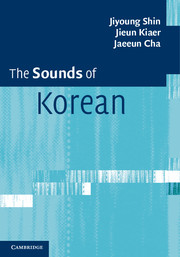Book contents
- Frontmatter
- Contents
- Figures
- Tables
- Preface
- Notational conventions
- 1 Characteristics of the Korean language
- 2 Production of sounds
- 3 Basic concepts of phonology
- 4 Consonants
- 5 Vowels
- 6 Frequency trends of Korean sounds
- 7 Prosody
- 8 Phonological rules of Korean (I)
- 9 Phonological rules of Korean (II)
- 10 Loanword phonology
- Notes
- Bibliography
- Index
3 - Basic concepts of phonology
Published online by Cambridge University Press: 05 November 2012
- Frontmatter
- Contents
- Figures
- Tables
- Preface
- Notational conventions
- 1 Characteristics of the Korean language
- 2 Production of sounds
- 3 Basic concepts of phonology
- 4 Consonants
- 5 Vowels
- 6 Frequency trends of Korean sounds
- 7 Prosody
- 8 Phonological rules of Korean (I)
- 9 Phonological rules of Korean (II)
- 10 Loanword phonology
- Notes
- Bibliography
- Index
Summary
In the previous chapter we discussed the general aspects of sound production, and learned that there are three steps in the production of sound: (i) initiation, (ii) phonation and (iii) articulation. Whereas the purpose of the last chapter was to help readers familiarise themselves with the physical basis of sound production, this chapter will focus on the abstract reality of sounds, and will introduce the background to phonology. Once speech sounds are produced by a speaker, they are transferred to a listener as a sequence of acoustic signals. These acoustic signals will then be understood by the listener according to his/her knowledge of the relevant language. Even if the listener has perfect hearing, without knowledge of the language being spoken, he/she will find it difficult to segment sounds or to distinguish between different sounds. Hence, in acquiring the sound system of our mother tongue we learn not only an inventory of sounds, but also how to determine which sound distinctions are significant and which not. Understanding the phonological basis of a sound system is also crucial for second language speakers. Together with Chapter 2, this chapter will provide a useful background for understanding the sounds of Korean.
- Type
- Chapter
- Information
- The Sounds of Korean , pp. 40 - 55Publisher: Cambridge University PressPrint publication year: 2012



